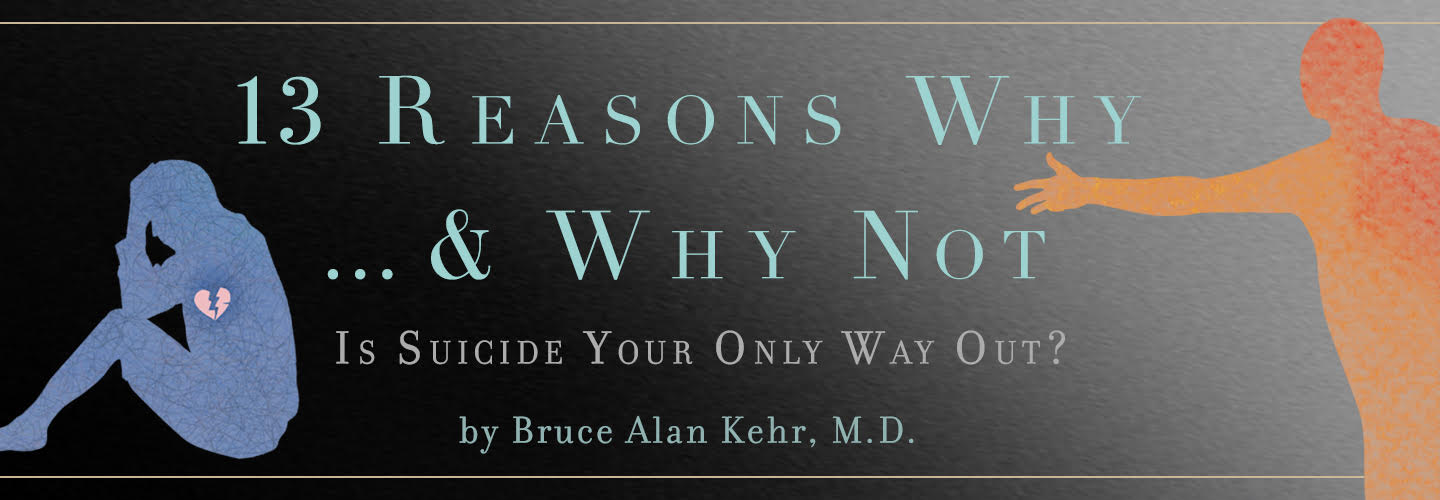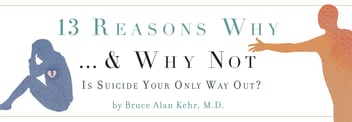A Personal Message from Bruce Alan Kehr, M.D., for Parents, Teachers and Counselors
- Home
- Blog

Last week I felt compelled to write a blog post that could be shared with high school and college students – 13 Reasons Why…and Why Not – Is Suicide Your Only Way Out? I encourage you to read it when you have finished reading this piece.
This companion post is designed to help parents, teachers, and counselors prevent teen suicide. I hope you’ll share it with others and use it as a basis for an honest conversation with the teen(s) in your life about how their life is going.
Have you heard about or watched the Netflix series, 13 Reasons Why?
If you have a child, niece, nephew, family friend, or student who is a teenager, chances are they are one of the millions of people who are talking about this thought-provoking, disturbing, at times horrifying story of the suicide of a teenage girl.
As a psychiatrist who has worked with many families dealing with this challenge, I am glad this show is bringing this serious issue out of the shadows into the light.
We need to have a national conversation about this topic. We need to do a better job of supporting our teens that feel so alone and misunderstood.
Did you know that suicide is the 3rd leading cause of death among 15-24 year olds?
Did you know that about 2/3 of people who complete suicide are depressed at the time of their deaths, and that depression that is untreated, undiagnosed or ineffectively treated is the #1 cause of suicide?
I am on a mission to ease emotional pain and end aloneness; and what I’ve learned in forty years of practice is that the pain of feeling “all alone” and that “No one cares” are often at the core of teens considering suicide.
Here are four steps to suicide prevention:
The Four E’s of Suicide Prevention
STEP ONE: EVALUATE
Pay attention to the changes in your child’s behavior.
Has your child become withdrawn, sullen, or persistently angry? Have they become more introverted and less involved with friends and in school activities? Are they showing symptoms of insomnia, a decline in school grades, rule-breaking behavior, spending much more time in their bedroom, crying spells, and quitting sports teams or after-school activities that they previously enjoyed? Write down any and all observations that describe these changes and the associated timeline for each. What are some of the possible triggers for what you are observing in them? What life experiences may be contributing? The answers to these questions will help you empathize with their plight and feel less scared and confused. With respect to a possible suicide risk with your child, look for the presence of one or more of these signs, including:
- Speaking about wanting to die or wanting to kill themselves
- Talking about feeling empty, hopeless, or having no reason to live
- Making a plan or looking for a way to kill themselves, such as searching online for methods to commit suicide, stockpiling pills, or buying a gun
- Talking about feelings of intense guilt or shame, feeling trapped
- Feeling hopeless – that there are no solutions to their problems
- Experiencing unbearable emotional or physical pain
- Talking about feeling like a burden to others
- Using alcohol or drugs to excess
- Acting anxious or agitated
- Withdrawing from family and friends
- Changing eating and/or sleeping habits
- Showing rage or talking about seeking revenge
- Excessive risk-taking that could lead to death, such as driving extremely fast
- Talking about or frequently thinking about death
- Displaying extreme mood swings, rapidly changing from very sad to very calm or happy or too good or grandiose; and then swinging back down again into depression
- Giving away valued possessions
- Saying goodbye to friends and family, or their pet
If one or more of these signs is present in the child, ask them directly how they are feeling, and whether they feel like hurting themselves, or that their life is not worth living. Asking these important questions will not trigger a suicide attempt, and may help them feel less alone with their emotional pain.
Find out what’s happening at school.
If your child is still in high school and two or more of these behavioral changes are present, contact their school and ask to speak with teachers or coaches to see if they have noticed any changes and, if so, when it began. Prepare a list of questions to ask them beforehand.
Contact their friends.
If your child attends high school or college and is unwilling to speak with you about your concerns and you have a good relationship with one or more of your child’s close friends, reach out to them to see if they are concerned. What are they observing? Tell them you don’t want them to reveal any confidences but that you are worried and want to help. Your inquiry and offer of support may alleviate a somewhat frightening burden that their friends are shouldering.
STEP TWO: EMPATHIZE
Communicate your emotional support.
In trying to communicate with and understand your child, approach them with humility. Ask for their help in getting to know them, for example, “Will you help me try to ‘get you’?” Let them know that your goal is to understand. Tell them that they are right when they feel you misunderstand them, and admit that you feel inept at times when you try to understand what they are living through. Ask them to be patient with you and that it is really important to you to understand them. Ask instead of argue, and listen with empathy and compassion. Questions like, “What’s happened to make you feel that way?” Ask if you can help. Let your child know that you are there to support and help them during this time of great transition and that they should not be afraid to report to you when they have done something they feel is stupid or shameful or that you would be angry about. Reassure them that you will not abandon or harshly judge them but will, instead, be constructive in finding a solution. Will this be difficult to discuss with them? If so, what gets in the way? How might you remove the obstacles?
Put yourself in their shoes.
To empathize more effectively, try to recall what it was like when you were the same age. What were the challenges in your life at that time? What did you want? What would you have wished for from your parents to help you feel better and cope more effectively? A note of caution: We unconsciously assume that our child is facing the same challenges that we did, that they are like a little me (or you), but their challenges are never identical to what we faced growing up. This part can be really tough to figure out, especially since their world may be very different from what you experienced. Your child needs you to look at things from their point of view to the best of your ability.
Consider counseling for yourself and/or your family if you think it would help you support your child better.
There are innumerable stresses on a family, some of which may contribute to a child’s vulnerability to suicide. Parental separation and divorce, unmasked infidelity, serious financial strains, chronic illness or death of a parent or grandparent, job loss, parental substance abuse, and frequent fighting in front of one’s children are just some of them. Working with a talented talk-therapist can make a huge difference in reducing the impact of these strains on the teen and teaching more effective ways to communicate and empathize with one another.
STEP THREE: ENLIST HELP
Act Quickly
It is important that your child’s condition be promptly evaluated before it worsens to a crisis point. Early intervention is the key to preventing suicide attempts and accelerating the recovery process. The more embedded the depression becomes, the longer it will take to effectively treat it, and the higher the risk of dangerous behavior. Are you reluctant to have your child seek treatment? If so, why? Who have you spoken with about this, and what do they think? Are feelings of shame or embarrassment in the way? What are you afraid of? Writing out the answers to these questions can help you gain clarity.
Choose their therapist carefully.
In selecting a professional to evaluate and treat your child, choose one whose treatment style includes parental involvement. It does not make sense to have your child living at home and treated in isolation from family dynamics that contribute to their depression or anxiety. What are some of the possible family dynamics that are tangling up your child’s life? Please write them down to present to the therapist.
Plan for the transition to college.
If your child has been treated for a mood, anxiety, or substance-abuse disorder and they are about to return to college, or enroll for the first time, arrange for them to continue treatment with their current therapist by telephone or videoconference. This is particularly helpful during this time of transition if they have a significant bond with the therapist. If there is not much of an attachment, arrange for them to be referred to a professional in the college town. Names can be obtained from the dean’s office, Student Health, or the office of disability services. Ask your child to interview with a few professionals until they find one with whom they feel a good initial fit.
If they are on prescription medication, arrange to have new prescriptions written to take to the local pharmacy near their school, or have their psychiatrist call in the medications by phone. Pack an extra supply of a month or two of these medications just in case there is a problem transferring them to the local pharmacy. Some parents continue to fill the prescriptions locally and mail or FedEx them to their child, if this is more reliable or convenient.
Gather local contacts.
When you travel with your child to move them into their dormitory room, introduce yourself to their roommate and obtain contact information for them and their parents, including mobile telephone numbers and e-mail addresses. In the future, if you have difficulty reaching your child, these contacts will enable you to find out what is going on.
STEP FOUR: EMANCIPATE AND COMMUNICATE
Trust, but verify.
If your child is living away from home, let them know that you don’t want to infringe on their independence, but you expect regular communication with them—at least once a week—and you want to establish a regular time for this (e.g., Sunday evenings). Skype and FaceTime are wonderful technologies that will enable you to feel that you are in your child’s dorm room with them during the weekly calls.
Support progressive levels of independence.
If your child is in high school, begin trusting their judgment, and letting them make mistakes. Don’t rush to the rescue unless those mistakes threaten to seriously derail their lives. Grant them more freedom as they take on greater responsibility. Establish an atmosphere whereby you gradually and progressively let go, lengthening the leash while trusting them. Recalibrate when they slip up with a nonthreatening conversation about what happened, and apply fair punishments that fit the “crime.”
Let go.
At a time like this the normal reflex is to take charge and protect your child. It’s important to remember that a teenager’s developmental task is to emancipate. Tread carefully. For example, don’t interfere with a high-school romance that appears to continue after your child leaves for college. Although it is understandable that you may want them to break off this relationship to fully experience campus life, you should not force this issue. A high-school sweetheart can serve as a bridge to provide comfort and support to your child at a time of high anxiety as they separate from home. If you give a lot of advice, you undermine your child’s prospects for becoming confident in making decisions; as the hidden message you communicate is that you believe they don’t know what they’re doing. You will need to learn how to tolerate your anxiety, instead of acting on these feelings through advice-giving. The only way they will develop wisdom (and self-confidence) is to live life, make some mistakes, and hopefully learn from them.
Communicate your approval.
Let your child know how proud you are of them and that you love and admire them when they demonstrate hard work, diligence, and sound decision-making. Emphasize that you believe in them and their ability to take on these new challenges. Let them know that you will always be there for them—no matter what—for emotional support and guidance.
This is undoubtedly an anxious time for you, particularly if your child (or student) has been in crisis. Don’t try to handle this all by yourself. Please consider taking the steps I’ve outlined above, and also read my prior posting, which is directed at better understanding what your teen may be living through.
You may help prevent a suicide!
Session Five in my book – “Heal an Existential Crisis in a Young Adult” – provides even deeper insights as well as workbooks for parents and young people, to help them make sense of this phase of life, work through the relevant emotional issues, and survive!
To learn more about how to prevent a suicide, and help a child recover from bullying, deal with PTSD or depression, please visit https://drbrucekehr.com/?s=cyberbully
For other articles on how to deal with emotional pain, aloneness and dark thoughts, please visit https://drbrucekehr.com/blog/, and feel free to sign up for our weekly e-mails that share insights and success stories of people who have overcome challenging times in their lives.
Related Information
13 Reasons Why…and Why Not – Is Suicide Your Only Way Out?
Learn more about suicide prevention
Cyberbullying, PTSD and Depression (Part 1)
Cyberbullying, PTSD and Depression (Part 2)
Cyberbullying, PTSD and Depression (Part 3)
Existential Crisis in Young Adults
Learn more about Dr. Kehr’s Books
Dr. Bruce Kehr’s psychiatry practice, Potomac Psychiatry
Dr. Bruce Kehr’s Weekly Insights, Subscribe
Dr. Bruce Kehr’s Blog
.png?width=144&height=144&name=Untitled%20design%20(34).png)



